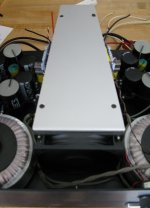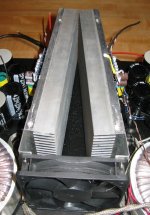give us picture from bird perspective
if you're just blowing in da case , effect is minimal
you must have proper intake opening at case , same as as proper outtake opening at case
use cunning cut Roentgen foil for tunnel sides forming , if needed ( it's wise to have some friend in local Hospital 😉 )
moi could cool 158MW with that htsink and lazy Noctua

if you're just blowing in da case , effect is minimal
you must have proper intake opening at case , same as as proper outtake opening at case
use cunning cut Roentgen foil for tunnel sides forming , if needed ( it's wise to have some friend in local Hospital 😉 )
moi could cool 158MW with that htsink and lazy Noctua

Last edited:
ZenMod said:give us picture from bird perspective
If you are taking requests, I would like to see a photo from a Gazelle perspective...
🙂 🙂 🙂 🙂 😀
give us picture from bird perspective
Intake openings are ~5X the area of the outlet, which was shown - the two opposed heatsinks with fins touching.
The intakes are:
a) rows of vent holes along sides of case - larger holes along the bottom and smaller holes along the top.
b) a row of ventilation slots in the top - located on the other side of the A-J boards from the fan (so resistor heat will be exhausted).
c) rows of vent holes in the case bottom immediately under the A-J boards.
Air speed through the heat sink 'tunnel' is fairly lazy to cool this...
Frank
Attachments
yes , but you must have defined tunnel from one side of case to other side of case
if you dont have cold air intake and hot air outtake , all you are doing is just warbling hot air in case
if you dont have cold air intake and hot air outtake , all you are doing is just warbling hot air in case
yes , but you must have defined tunnel from one side of case to other side of case
Sorry! Here the top of the tunnel is opened up, so you can see the heat sink fins and the position of the thermocouple (yellow heat shrink) for temperature readout. The case layout with closed front was intended to minimize fan noise in the room. Again, air inlets to the interior of the case are via rows of holes in the sides, bottom, and slots in the rear top. The fan draws that cool air past all of the interior components and then blows it out the back over the heatsink fins. The full back plates are not yet made, but will be split so the rear of the heatsinks are open.
Again, with the 12V 1200 rpm fan at full speed, the heatsinks rise about 24 degrees C above ambient. That fan speed is audible outside, though not annoying. With the fan slowed down just beyond the threshold of being heard outside the case, the heat sink temperature rise is ~30 degrees C. So I think I don't want more bias because in summer the ambient air temperature can easily be 10C higher. That means about 60C for silent operation, 55C when I'm rocking-out and don't care about a little fan noise. 😉 What do you think about those operating parameters?
Cheers!
Frank
Attachments
Bottom line thus far - disappointed with the sound when driven by the Legato I/V stage on the DAC. It's not just the lack of volume but the lack of 'guts'. My Legato puts out about 1.7 Vrms @ 0 db (balanced). The amp sounds significantly better driven single ended by a preamp giving ~2V. I don't want a 'preamp' and I don't want to run single-ended... 

some more info wouldn't make any harm ....
what's between Legato and J ?
link to Legato sch will help , too - there are to much variations for my peanut memory
what's between Legato and J ?
link to Legato sch will help , too - there are to much variations for my peanut memory
Balanced circuits have double the circuit noise of a single ended circuit. A balanced circuit is only a benefit if you have significant external noise getting into your interconnects. A balanced circuit will not sound better simply because it is balanced. See Doug Self's book on Small Signals for a pretty in depth description of this.
Small Signal Audio Design - Douglas Self - Google Books
Around and after page 344.
Small Signal Audio Design - Douglas Self - Google Books
Around and after page 344.
don't be so sure
one can claim that only for specific case , not generally
if balanced ( or any iteration of it ) is inherent to circuit construction , in most cases it will sound better than same circuit is used as any sort of SE/Bal converter
regarding Aleph J , some say that best sound is when inputing it balanced ; but I also know one serious audio designer who claims that ( for his ears ) Aleph J is sounding better when inputing it SE , but with positive leg grounded and minus leg used as active;
didn't asked him for variation with spk wires phase swapped
go figure
one can claim that only for specific case , not generally
if balanced ( or any iteration of it ) is inherent to circuit construction , in most cases it will sound better than same circuit is used as any sort of SE/Bal converter
regarding Aleph J , some say that best sound is when inputing it balanced ; but I also know one serious audio designer who claims that ( for his ears ) Aleph J is sounding better when inputing it SE , but with positive leg grounded and minus leg used as active;
didn't asked him for variation with spk wires phase swapped
go figure
Yeah, I should have had my thinking cap on rather than my lecture cap. Going into a circuit that is inherently balanced probably WOULD be better to have a balanced pre into it.
The noise issue still exists but without hearing it I would guess that balanced into the J would sound better than single ended.
Something that might be tried is a Cinemag 1:1 transformer to go from SE to Bal. These transformers perform incredibly. I tested one on my AP and it was near 0 distortion. Basically the specs were quite a bit better than the datasheet and the sound was wonderful. If I had a pre that was already SE and I wanted BAL then this is a simple fix that costs about 100usd for stereo and sounds fantastic if the SE pre before it also sounds fantastic.
The noise issue still exists but without hearing it I would guess that balanced into the J would sound better than single ended.
Something that might be tried is a Cinemag 1:1 transformer to go from SE to Bal. These transformers perform incredibly. I tested one on my AP and it was near 0 distortion. Basically the specs were quite a bit better than the datasheet and the sound was wonderful. If I had a pre that was already SE and I wanted BAL then this is a simple fix that costs about 100usd for stereo and sounds fantastic if the SE pre before it also sounds fantastic.
some more info wouldn't make any harm ....
what's between Legato and J ?
link to Legato sch will help , too - there are to much variations for my peanut memory
Your generosity in willing to help is greatly appreciated! Now I'm completely out of time for about a month. But I will get back to it ASAP so any/all advice is welcome. The J input resistors are currently 'stock' values. I would like to drive it directly from the I/V stage of the DAC: http://www.twistedpearaudio.com/docs/linestages/legato_3.1_schematic.pdf
Mine is tweaked slightly for higher-than-stock output of about 1.7Vrms.
With only wire between the I/V stage and the amp, it sounds like there is nowhere near enough current entering the A-J...
...back to work here... 😎
Frank
Is that OPA IV. Should be plenty of beef if speakers are somewhat efficient.
...that's what I thought... driver efficiency is 89dB/W
IIRC, output impedance of the I/V is about 2k (???)
This I/V sounds very nice directly into a balanced 3886 chip amp in which each side has 10X gain.
BTW, for later, what are the best locations from which to check bias current? ...and any tricks to that?
TIA,
Frank
Frank - if you're willing to toss entire OP shebang on right side and invest in pair of Lundahls , you'll have much better sound - balanced or SE , by your choice
look for AR2's posts regarding that solution
look for AR2's posts regarding that solution
Zm knows of what he speaks. Are you suggesting the Lundahls feed the OPA or just straight IV duties?
I'm suggesting Lundahl after I/V conversion , ditto to attenuator ditto to Aleph J
buffer between attenuator and Aleph J is matter of choice , and inteconnects
buffer between attenuator and Aleph J is matter of choice , and inteconnects
- Home
- Amplifiers
- Pass Labs
- Aleph J Schematic

